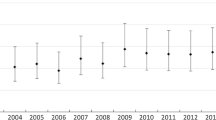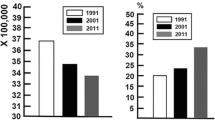Summary
We have undertaken an epidemiological study of fractures of the hip which occurred in the Honam area of Korea during the year 1991. Honam comprises 3 districts, Kwangju, Chonnam, and Chonbuk. On November 1st 1991 the total population over the age of 50 years in Honam was 1,205,370. During the year there were 405 fractures of the neck or intertrochanteric region of the femur, an incidence of 3.4 per ten thousand per year. The age specific incidence rate showed a gradual increase. The incidence rate showed seasonal variations being higher in the summer and fall, and lower in the winter and spring. The incidence in urban areas was higher than in rural regions to a level which was statistically significant. The average age of patients was 70.2 years (range 50 to 94 years). The most common cause of injury was a simple fall (61%). There were 212 females and 193 males, a ratio of 1.1:1. There were 196 fractures of the neck and 209 of the intertrochanteric region. The degree of osteoporosis increased with age. About half of the patients (49.9%) showed definite osteoporosis, the degree being higher in women and in fractures of the neck of the femur. Treatment was by operation in 328 patients (81%); 77 patients were treated conservatively or had no treatment (19%). Of the 360 patients whose final outcome was known, 26 died within three months of injury, a mortality of 7.22%. The mortality was 3.8% (11 out of 292) in patients who underwent operation, whilst it was 22.1% (15 out of 68) in patients who were treated conservatively or remained untreated. Patients who underwent operation had a lower level of mortality at 3 months and were more active than those who did not have surgery.
Résumé
Les auteurs ont réalisé une étude épidémiologique des fractures de hanche qui se sont produites pendant un an (1991) dans la région de Honam (ville de Kwangju, province de Chonnam et province de Chonbuk). La population de plus de 50 ans (à la date du ler Novembre 1991) était de 1.205.370 personnes. Le nombre total de patients présentant une fracture de la hanche (fractures du col et fractures trochantériennes) a été de 405, ce qui représente un taux annuel de 3,4 pour mille. Leur fréquence augmente progressivement avec l'âge. Elle présente également des variations saisonnières: elle s'élève en été et en automne, elle diminue au printemps et en hiver. Elle est plus importante dans les villes qu'à la campagne. L'âge moyen des patients est de 70,2 ans. La cause la plus commune des fractures est la chute après glissade. Parmi les patients on compte 212 femmes et 193 hommes; le rapport homme/femme est de 1:1,1. Il y a 196 fractures du col et 209 fractures trochantériennes. Le degré d'ostéoporose s'élève avec l'âge. La moitié des malades environ (49,9%) présentent une nette ostéoporose. Celle-ci est plus marquée chez les femmes et dans le groupe des fractures du col. Le traitement a été chirurgical dans 328 cas (81%) et orthopédique (ou non effectué) chez 71 patients (19%).
Similar content being viewed by others
References
Bauer GCH (1960) Epidemiology of fracture in aged persons. A Preliminary investigation in fracture etiology. Clin Orthop 17: 219–225
Caniggia M, Morreale P (1989) Epidemiology of hip fracture in Siena, Italy, 1975–1985. Clin Orthop 238: 131–138
Chalmers J, Scotland E, Ho KC (1970) Geographic variations in senile osteoporosis. J Bone Joint Surg [Br] 52: 667–675
Cummings SR (1985) Are patients with hip fractures more osteoporotic? Review of the evidence. Ann J Med 78: 486–494
Dahl E (1980) Mortality and life expectancy after hip fractures. Acta Orthop Scand 51: 163–170
Dretakis EK, Giaourakis G, Steriopoulos K (1992) Increasing incidence of hip fracture in Crete. Acta Orthop Scand 63: 150–151
Elabdien BSZ, Olerud S, Kalstoom G, Smedby B (1984) Rising incidence of hip fracture in Uppsala, 1965–1980. Acta Orthop Scand 55: 284–289
Evans JG (1979) Fracture proximal femur in Newcastle upon Tyne. Age and Ageing 8: 16–24
Falch JA, Ilebekk A, Slungaard U (1985) Epidemiology of hip fractures in Norway. Acta Orthop Scand 56: 12–16
Finsen V, Benum P (1987) Changing incidence of hip fracture in rural and urban areas of central Norway. Clin Orthop 218: 104–111
Gallagher JC, Melton LJ, Riggs BL, Erik Bergstrath BA (1980) Epidemiology of fracture of the proximal femur in Rochester, Minnesota. Clin Orthop 150: 163–171
Halpin JP, Nelson CL (1980) A system of classification of femoral neck fracture with special references to choice of treatment. Clin Orthop 152: 44–48
Hedlund R, Ahlbom A, Lindgren U (1986) Hip fracture incidence in Stockholm 1972–1981. Acta Orthop Scand 57: 30–34
Ions GK, Stevens J (1987) Prediction of survival in patients with femoral neck fractures. J Bone Joint Surg [Br] 69: 384
Johnell O, Nilsson B, Obrant K, Sernbo I (1984) Age and sex patterns of hip fracture changes in 30 years. Acta Orthop Scand 55: 290–292
Larsson S, Eliasson P, Hansson LI (1989) Hip fracture in Northern Sweden 1973–1984. Acta Orthop Scand 60: 567–571
Levine S, Makin M, Menczel J, Robin G, Naor E, Steinberg R (1970) Incidence of fracture of the proximal end of the femur in Jerusalem. J Bone Joint Surg [Am] 52: 1193–1202
Luthje P (1985) Increase of hip fracture in Finland. A forecast for 1990. Acta Orthop Scand 56: 223–225
Mannius S, Mellstrom D, Rundgren A, Zetterberg C (1987) Incidence of hip fracture in western Sweden 1974–1982. Acta Orthop Scand 58: 38–42
Ross PD, Norimatsu H, Davis TW, Yano K, Wasnich RD, Fujwara S, Hosoda Y, Melton LJ (1991) A comparison of hip fracture incidence among Native Japanese, Japanese Americans and American Caucasians. Am J of Epidem. 133: 801–809
Rowe SM, Song MJ (1989) Osteoporosis in fractures of the proximal femur. Chonnam Med J Med Sci 2: 60–65
Singh M, Nagrath AR, Maini PS (1970) Changes in trabecular pattern of the upper end of the femur as an index of osteoporosis. J Bone Joint Surg [Am] 52: 457–467
Stevens J, Freeman PA, Nordin MEC, Barnett E (1962) The incidence of osteoporosis in patients with femoral neck fracture. J Bone Joint Surg [Br] 44: 570–527
Tronzo RG (1973) Surgery of the hip joint. Lea & Febiger, Philadelphia, pp 559–565
Zetterberg CH, Anderson GBJ (1982) Fractures of the proximal end of the femur in Goteborg, Sweden, 1940–1979. Acta Orthop Scand 53: 419–426
Author information
Authors and Affiliations
Additional information
Reprint requests to: S.M. Rowe
Rights and permissions
About this article
Cite this article
Rowe, S.M., Yoon, T.R. & Ryang, D.H. An epidemiological study of hip fracture in Honam, Korea. International Orthopaedics 17, 139–143 (1993). https://doi.org/10.1007/BF00186373
Issue Date:
DOI: https://doi.org/10.1007/BF00186373




